The All Terrain Scout Transport (AT-ST), also known as a Scout Transport, Scout Walker, or derisively as a chicken walker, was a lightweight, bipedal walker used by the ground forces of the Galactic Empire. Later, the First Order used an updated variant of the AT-ST within their military.
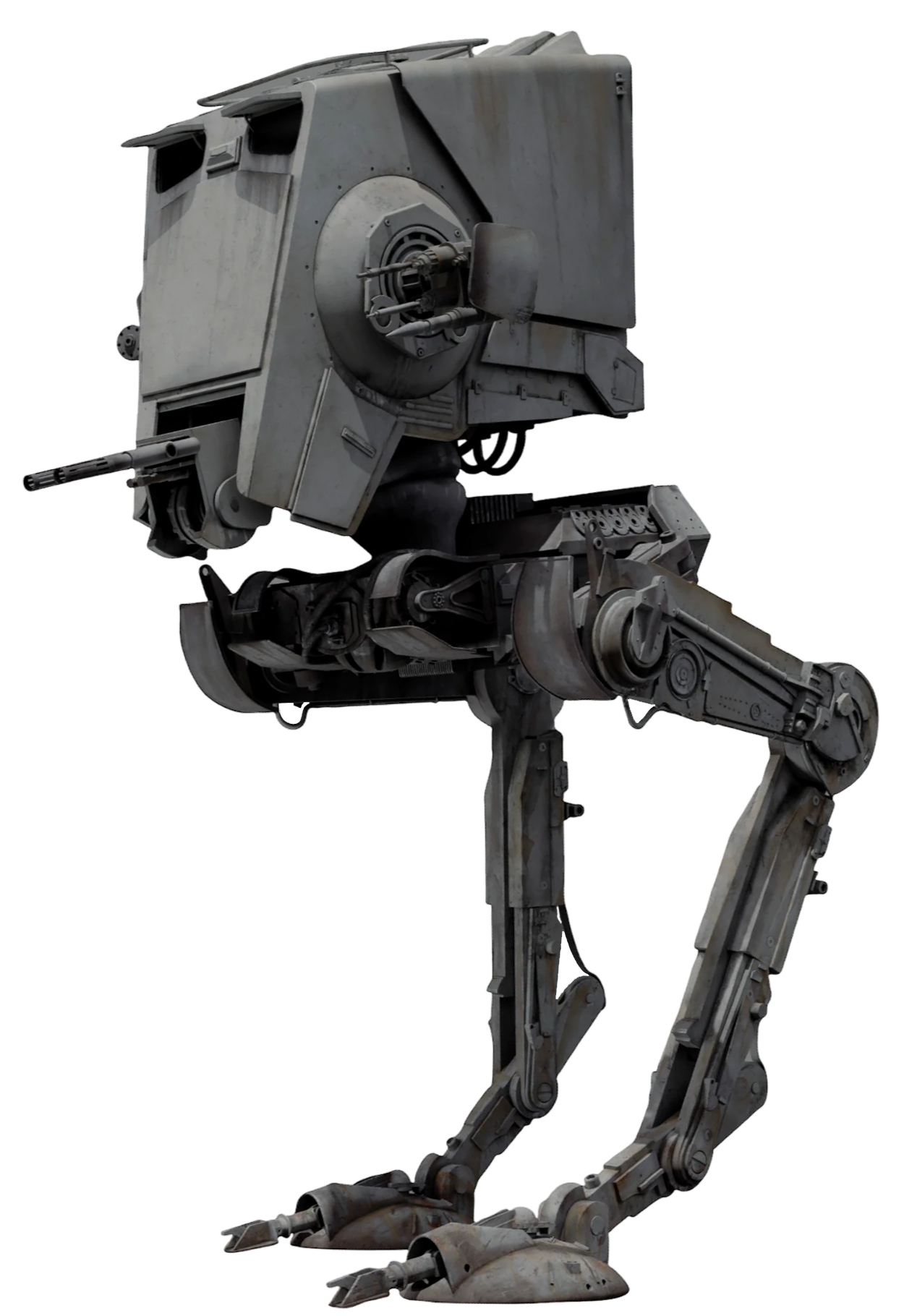
A partial side view of an AT-ST
The All Terrain Scout Transport (abbreviated to AT-ST) was a scout and reconnaissance light walker of the Galactic Empire's All-terrain vehicle line. It consisted of an armored command and control cabin mounted on two gyro-stabilized legs and was utilized for battle line support, antipersonnel hunting and troop support. They were also commonly used to screen the flanks of larger assault walkers for major ground operations, during which they supported heavier walkers such as AT-ATs by eliminating pockets of resistance and clearing out denser terrain such as small canyons and cities along the path of a planned invasion route.
The command cabin featured two armored viewports which were deliberately set to give any viewer the unsettling sensation of staring into the face of a soulless beast or oversized combat droid, despite not actually being needed due to the AT-STs extensive sensor package. Inside the control cabin, the command module featured multiple holoprojectors which displayed a holographic 360-degree view of the combat zone. The cabin (or "head") itself was capable of rotating 240 degrees side to side, greatly benefiting the gunner's target-acquisition abilities and capabilities for destruction. A cooling system was equipped above the command module behind the entry hatch.
AT-STs were equipped with two chin-mounted MS-4 twin blaster cannons with a range of two kilometers. They also featured one cheek-mounted 88i twin light blaster cannon and one cheek-mounted DW-3 concussion grenade launcher capable of doing massive damage to enemy vehicles and ground troops at close range and used at dealing with large amounts of infantry as well as mounted turrets that were too risky to be taken out with rocket launchers. AT-STs were also equipped with retractable footpad blades which could slash apart wires and fences at ground level. The modular design of the All Terrain Scout Transport allowed for ease in customizing the walker with armaments and tools for specific mission parameters, including mortar launchers that could be attached to the command pod of the AT-ST.
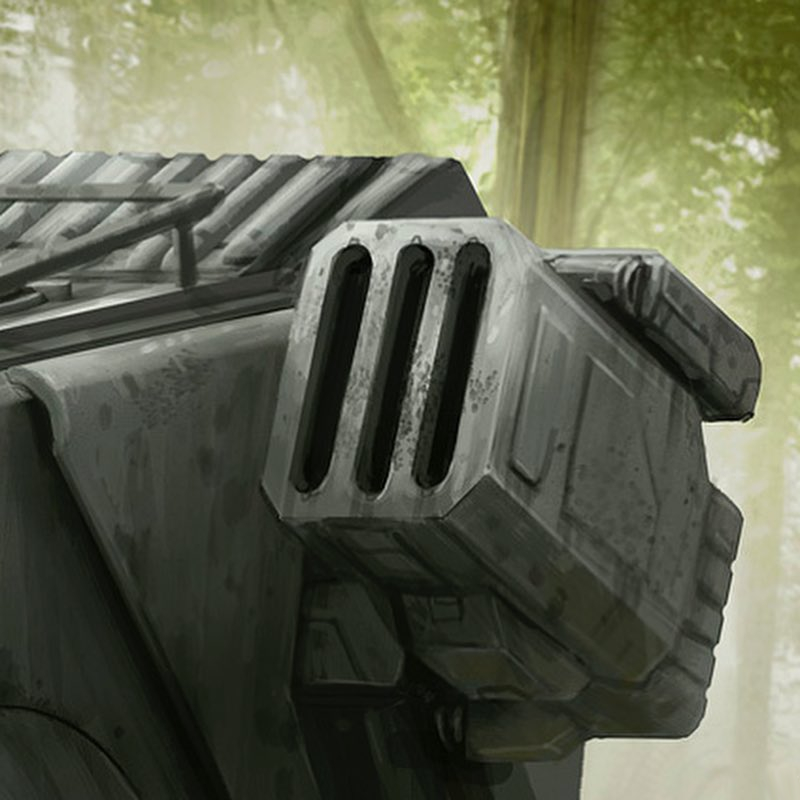
A mortar launcher attached to the command pod of an AT-ST
Several areas of the walker's hull were reinforced with armored plates, including the rear of the command cabin which featured the weapon power converters, the front (or "face"), the joints and the gyro-stabilizing system. In addition, reinforced armor plates enveloped the control cabin, protecting the two-person crew from small-arms fire, but not laser cannons, missiles, or other heavy ordnance.
Due to its small size, the AT-ST could not be equipped with an onboard full power generator, and as such relied on eight disposable high-intensity power cells mounted directly at its drive engine. Two more cells powered the cabin gyro for redundancy. Despite covering the walker's high energy needs, these power cells greatly limited its range.
The walker's deceptively rickety gait belied a potent patrol vehicle. Gyros and flexible joints formed a complex system that controlled balance and stabilized the walker across a variety of terrains. Sophisticated shock-absorbers built inside the lower legs of the walker kept it stable at all times, while a variety of sensors built within its footpads offered detailed feedback on the terrain the AT-ST was moving through, reading intensity and contour for precise foot placement. The locomotion computer mounted in the command cabin could take control of the walker and use the information relayed from the sensors to drive it autonomously over even ground, although an experienced pilot was still needed over complex terrain.
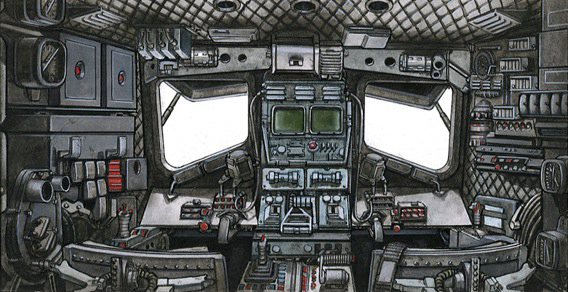
The AT-ST command module
Despite its speed and agility, an AT-ST walker's offensive and defensive power were significantly compromised. Offensively, its weapons systems were only good against lightly armored targets at close range. Defensively, its lighter armor could repel attacks from small-arms fire, but not laser cannons, missiles, or other heavy ordnance. Its armor did not cover its entire frame, lest the walker lose its agility. Striking the walker's unprotected gyros underneath the command module could destabilize the walker and cause it to fall. Additionally, deep trenches or cable lines leveled at the height of the AT-ST's ankles and knees could cause it to trip and topple the vehicle. AT-STs are also known to require constant maintenance, having perhaps the highest maintenance-per-hour record in the entire Imperial Army.
The Ewoks of Endor discovered that the AT-STs were vulnerable to anti-Gorax traps. Ramming logs could smash through the walker's head, destroying the cockpit. One of its other weaknesses was its susceptibility to hijacking, despite the height of the vehicle seemingly making hijacking an impossibility. A sufficiently strong force could rip the entrance hatch off the top of the walker. If commandeered, the walker's cannons could easily penetrate other AT-STs' armor.
The All Terrain Construction Transport saw use for construction proposes.
Also known as the "Strider," the All Terrain Exploration Transport was itself a smaller version of the .
The All Terrain Scout Transport/Assault was a direct assault variant of the AT-ST.
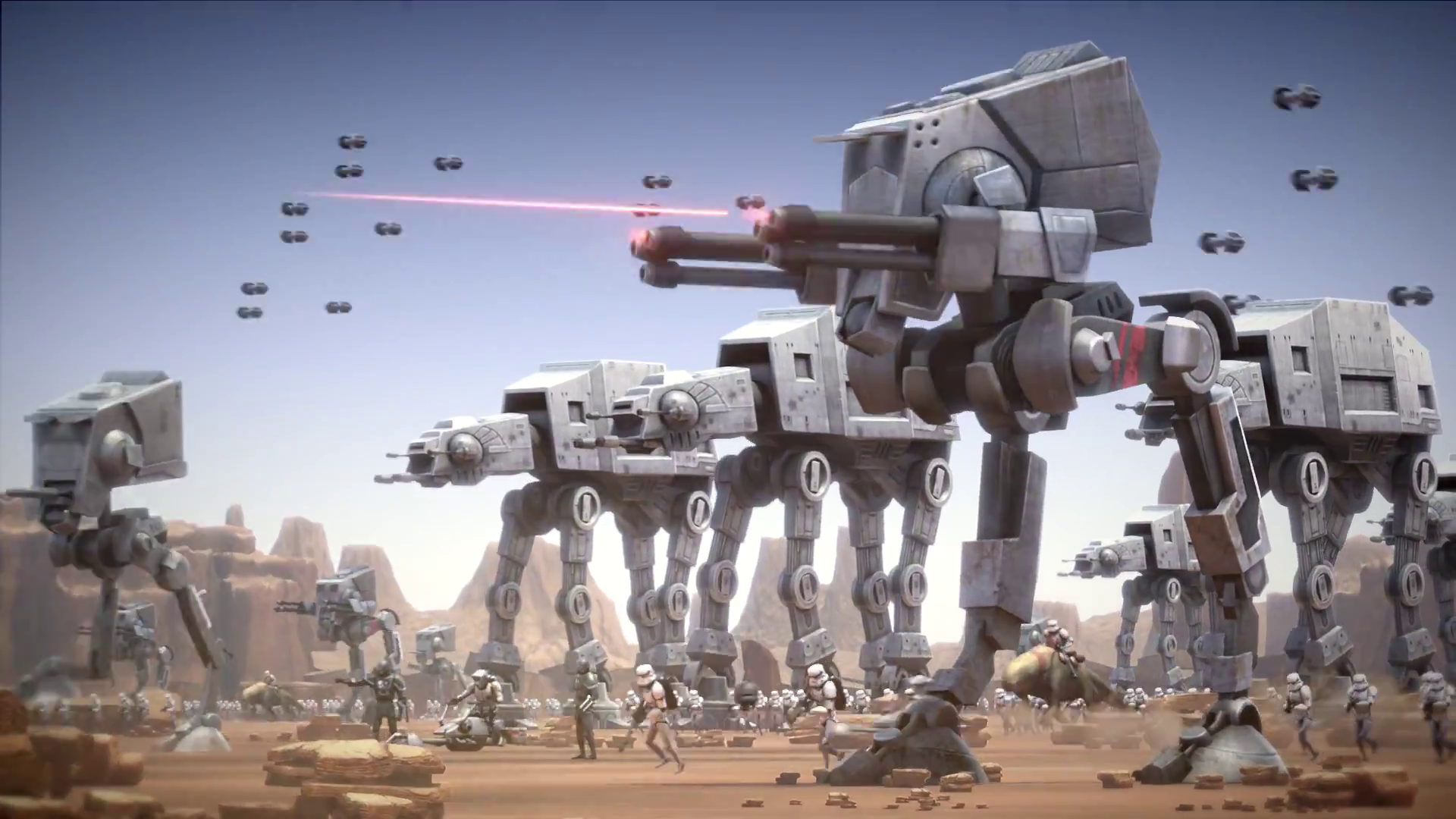
An AT-ST Mark III marches into battle
The AT-ST Mark IIIs were equipped with experimental armor that provided more speed and durability than that of the standard AT-ST. Mounted with twin heavy laser cannons and piloted by veteran crews, they excelled against most targets.
A variant used by a Klatooinian tribe.
The enhanced AT-ST Walkers boasted enhanced power couplings and sub-systems, allowing their weapons to fire high-powered blasts at a faster rate than average. They also had dark armor plates.
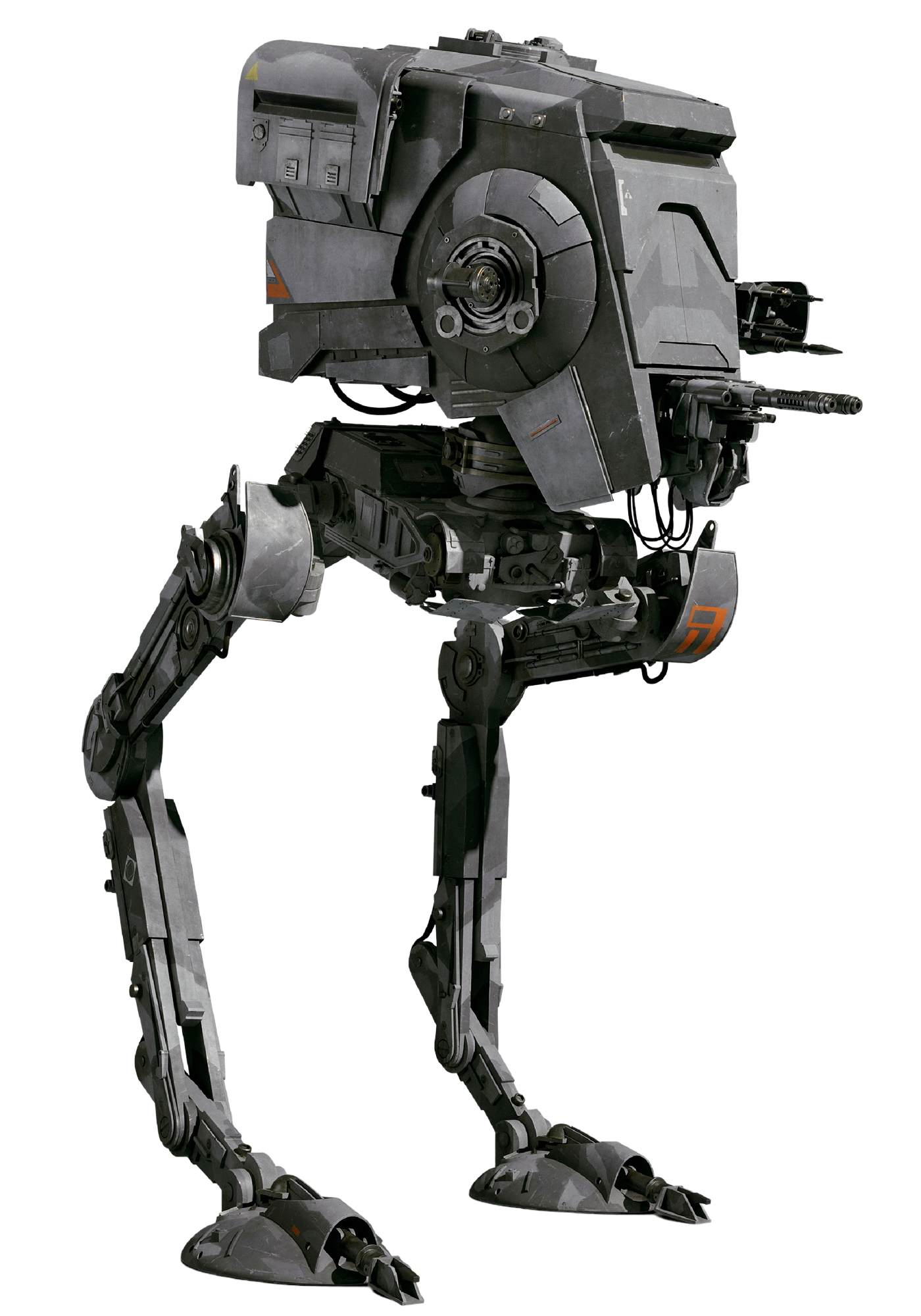
The AT-ST variant fielded by the First Order.
The First Order utilized an updated version of the AT-ST that featured upgraded armor and gyroscopic systems. Several of them were stored aboard the Supremacy.
The All Terrain Heavy Scout was a highly evolved variant of the First Order AT-ST, which saw service in the First Order Army during the intergalactic First Order-Resistance War.
Part of the All-Terrain walker family, the AT-ST's role in supporting Imperial ground operations earned it the moniker "scout walker" owing to its ability in ferreting out enemy positions and inspecting locations in advance of larger walkers. It was better equipped than the Republic AT-RT and was in service by the Invasion of Mon Cala in 18 BBY.
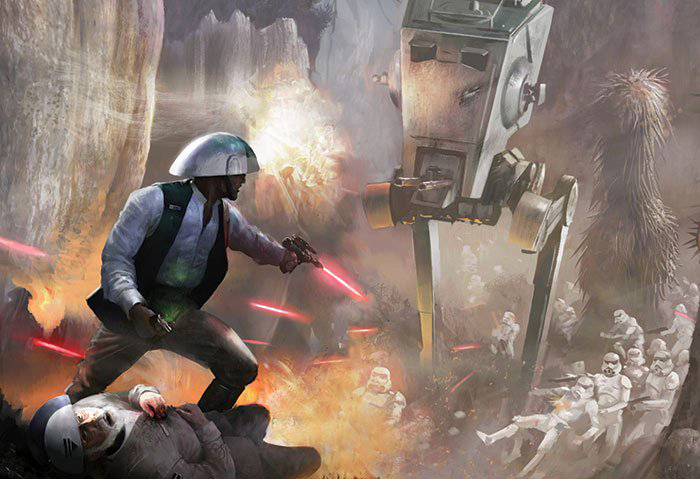
Like the rest of the Imperial Army, AT-STs fought rebellious forces, including the Rebel Alliance during the Galactic Civil War.
In 14 BBY, an AT-ST attacked the Stinger Mantis ship on Zeffo, but was destroyed by the Jedi Padawan Cal Kestis. The Empire used AT-STs against the Partisans led by Saw Gerrera on Kashyyyk and Kestis, who helped the rebel group during the battle to take over an imperial refinery. The AT-STs were on Ilum when the Empire started mining the world to acquire Kyber crystals. When Kestis went to the planet to find a crystal to build a new lightsaber, two AT-STs were destroyed by the Padawan during his escape from the world.
The Imperial Military commonly used the AT-ST in a variety of environments. After rebel leader Saw Gerrera and his Partisans took to defending the world of Jedha, AT-STs were among the reinforcements deployed to aid the planet's occupying garrison; with the ancient Holy City consumed by surface warfare, the AT-STs were fielded for urban pacification against the Partisans whenever they could fit into the city's winding and narrow streets. While accordingly impractical during the Jedha insurgency, the walkers were also fielded to try to send a message beyond their blaster fire, but the Partisans instead chose to intensify their efforts against the garrison. With the Empire retaliating in equal force, battle continued in the streets, with AT-STs devastating the city and civilians. Even so, both sides continued to fight, with one AT-ST being deployed in Tythoni Square as part of the battle on Jedha in 0 BBY. The insurgency ended when all but at least three percent of the Imperial garrison retreated under Protocol 13. Afterward, the DS-1 Death Star Mobile Battle Station destroyed the Holy City.
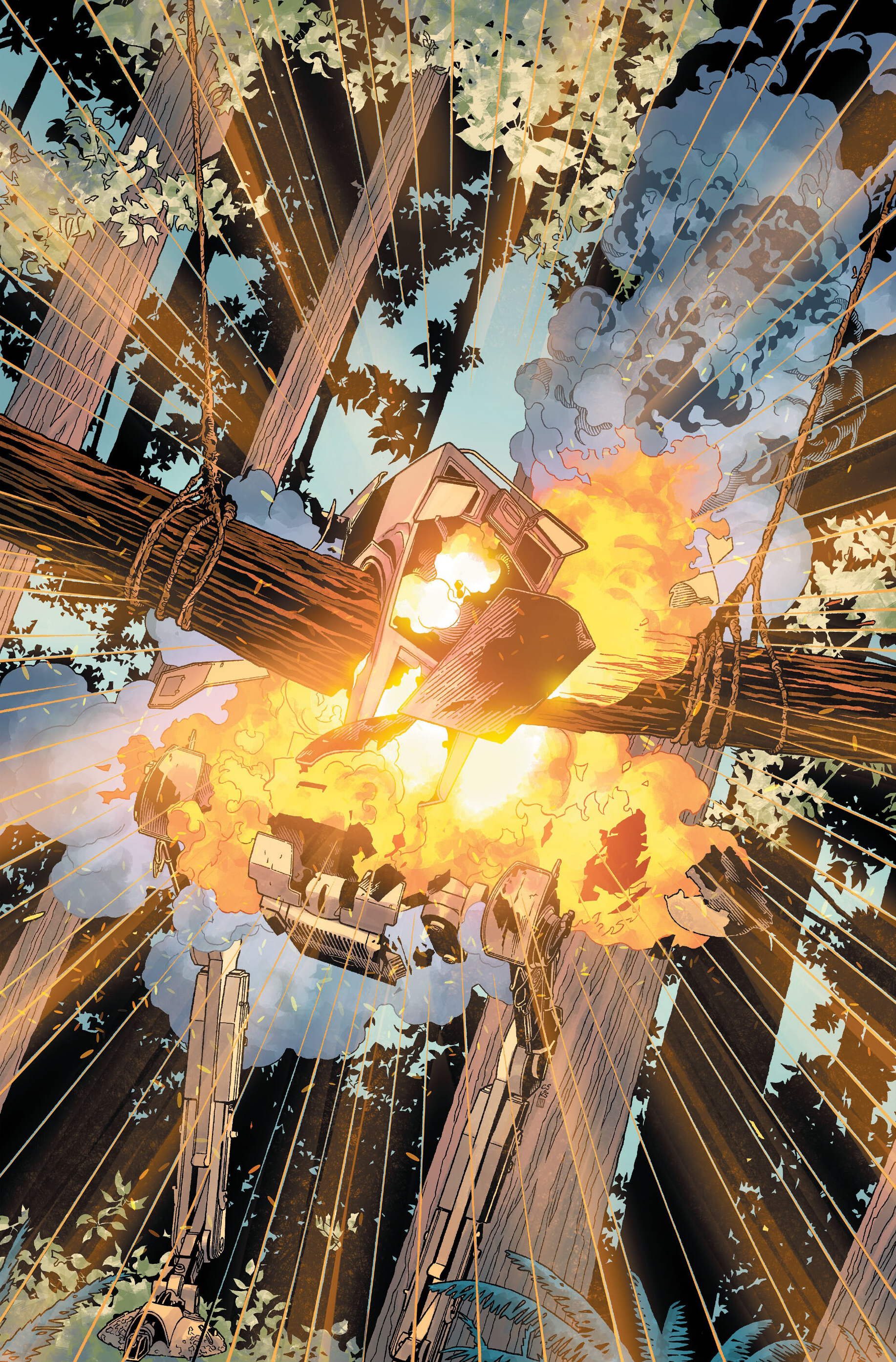
An AT-ST succumbs to Ewok traps during the Battle of Endor
The walkers were also used in the Galactic Civil War. At least one fought in the Battle of Allst Prime. General Weiss commanded a customized AT-ST. Between the Battle of Yavin and Battle of Hoth, the Alliance to Restore the Republic operated stolen AT-STs, and provided them to Saponza's Gang, who often fought against the walkers. Three AT-STs were deployed as part of Lieutenant-Inspector Magna Tolvan's attack on the Son-tuul Pride crime syndicate. Several fought alongside All Terrain Armored Transports (AT-ATs) at the Battle of Hoth. They also notably participated in the Battle of Endor, where they were defeated by the Ewoks and their anti-Gorax traps. One walker, Tempest Scout 2, was captured by the rebel Wookiee Chewbacca and two Ewoks, Widdle Warrick and Wunka.
The walkers were also used by the Empire in the final battle of the Galactic Civil War, the Battle of Jakku, which ended up being an overwhelming victory for the New Republic. In 9 ABY, an AT-ST was used by looters to attack a village on the planet Sorgan. The AT-ST became embroiled in the battle between the looters and the village people, who were suddenly led by Mandalorian bounty hunter Din Djarin and former rebel shock trooper Cara Dune. In the end, Djarin destroyed the walker with a grav charge.
Thirty years after the close of the Galactic Civil War, a splinter military group of the New Republic called the Resistance utilized old Imperial AT-STs in combat against the reorganized remnants of the Galactic Empire, the First Order. They possessed an orange repaint and were crested with the Resistance starbird.
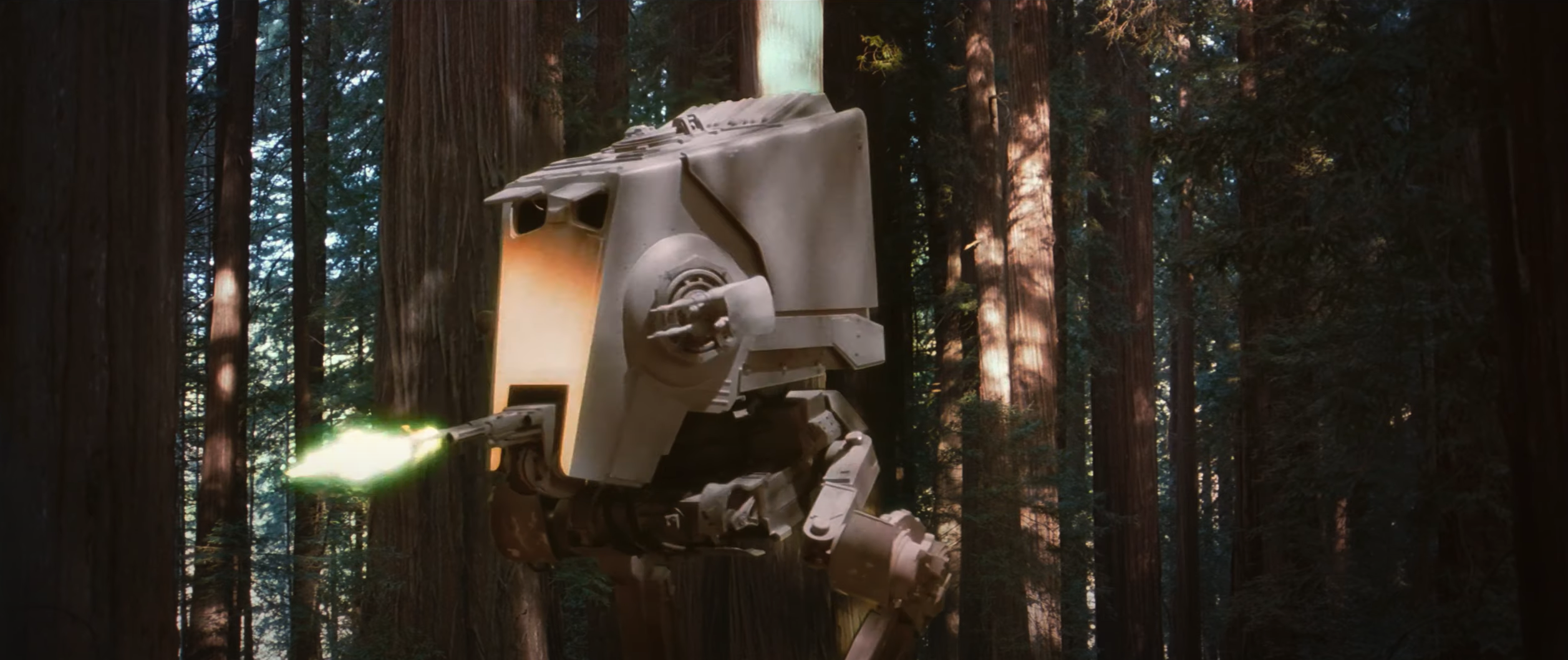
An AT-ST during the Battle of Endor
All Terrain Scout Transports first appeared in the 1980 motion picture Star Wars: Episode V The Empire Strikes Back. The AT-ST model received some cosmetic changes for its extensive appearance in the 1983 film Star Wars: Episode VI Return of the Jedi, thus explaining the minor differences in the models used for the two films.
- Disney Infinity 3.0
- LEGO Star Wars: The Force Awakens
- LEGO Star Wars: The Skywalker Saga
- LEGO STAR WARS: Celebrate the Season — "New Year's Hothin' Eve"
- LEGO Star Wars: The Freemaker Adventures — "A Hero Discovered"
- LEGO Star Wars: The Freemaker Adventures — "Return of the Kyber Saber"
- LEGO Star Wars: The Freemaker Adventures — "Flight of the Arrowhead"
- LEGO Star Wars: The Freemaker Adventures — "A Perilous Rescue"
- Star Wars: Visions — "THE TWINS"
- Star Wars: Visions — "T0-B1"
- Star Wars: Visions — "The Spy Dancer"
- "Corellian Run" — LEGO Star Wars 58
- LEGO Star Wars: Choose Your Side: Doodle Activity Book
- LEGO Star Wars: Build Your Own Adventure
- The Art of Star Wars: Visions